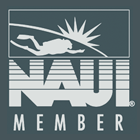This blog series details the travels and experiences of SeaTrek’s Gus Meloy, a geologist going through the pinnacle of his education. Six weeks of intense field and course work are described while providing insight about the country of New Zealand. This is a unique perspective he intends to share through a series of entries.
Week 1: Where Else To Start But The Beginning
Early in the morning we met in Wellington. A small group of six students and two professors climbed into two Massey University vans, bound for the South Island. Wellington is an important port city and the Capital of New Zealand. The ferry took us across the Cook Strait that divides the North and South Islands. The seas were calm that day making for a pleasant crossing. 3 hours after departing, we had arrived in Picton, a small town that’s biggest claim to fame is being the ferry port. We needed to go west to get to Collingwood. Unfortunately, the road system leaves very little choice when planning your route. We had to drive two hours “out of the way” just to get us to the right road that could take us to Collingwood. Though inconvenient, we were able to see the countryside for the first time.
New Zealand relies heavily on its natural resources for its economy. My professor, Karoly Nemeth, explained very well that most of the trees that you see are non-native and are tree farms. Timber is a huge export for the Kiwi’s and this is reflected throughout the country. Different tracks are cut and then replanted in a cycle so that you have a crop each year, but the percentage taken is quite small and mitigates the negative effects of deforestation. What is even more apparent as you drive through New Zealand is that wine is important to the economy as well. The valleys were either filled with vineyards or pastures containing sheep and/or cattle. Many young people travelling choose to work the vineyards part time, often at more than one vineyard, as a means of paying for their travel and to see New Zealand. This is encouraged by the Kiwis; obtaining a temporary work permit is fairly easy to do. There is great national interest in maintaining New Zealand’s natural resources and beauty. National parks are everywhere and the economy is dependent upon tourists, timber, wine, and fishing. What you don’t see a lot of are people. I lived in rural settings all my life so this was no shock to me, but what you have to understand is that New Zealand is home to 4.5 million people, 2.5 million of which live in the city of Auckland alone. This leaves a modest 2 million people spread around the rest of the country. Small town living is easy to find here.
We arrived in Collingwood where we would stay for the next five nights. The “holiday park” as they call it down there had several small dorm style units that we stayed in. Everyone staying in the park shared kitchen/laundry/bathroom facilities. If you are traveling to New Zealand these are great places to stay as they are far cheaper than a hotel.
Our first day in the field, we went to Cape Farewell. This is the last spit of land on the tip of the South Island. We stopped at the information center/café to discuss the local geology over cappuccinos. The story in Cape Farewell in terms of what you see today is tied closely to the geomorphology. Bordering the Tasman Sea to the west, you will find a rocky shore which is also the windward side. Waves crash into the exposed rock and even carve out arches. At the very tip farthest north, however, the current is unimpeded by rock and can flow from west to east. This creates a very large sandy cape complete with dunes that are reworked by the wind as well. The more distal or farther east you go, the younger the sand deposits. This cape has created a protected area known as Golden Bay. This bay is very shallow as it has become choked with sediment from small rivers that in times of storm erode away the hills. After much hiking and a quick swim in the ocean we had concluded our first day and went back to Collingwood.
Food was a highlight of the trip. By some miracle, we were all good cooks so we split into four teams of two that would be responsible for making a dinner one night and just rotate from there. Karoly, the lead professor, was from Hungary and would have made a fine chef if it weren’t for being a brilliant geologist. His meals were legendary, more on that later. For breakfast we kept it simple with ceral, toast, etc… You were responsible for making and packing your own lunch into the field every day, I ate a lot of sandwiches. The local fruit was fantastic as well. The oranges don’t look as good as they do in the States but they taste a lot better, don’t judge an orange by its peel.
After our first dinner that included lamb chops, bratwurst, grilled eggplant, onions, and asparagus we talked about where we would be in the field for the next few days. The reason we had come to this region was to visit the Cobb Valley Reservoir and the surrounding area. This area is unique and it’s where you will find the oldest rocks in New Zealand. The rocks are Cambrian to Ordovician in age (roughly 550 to 450 million years old). The landscape was carved glacially which is apparent from the wide, u-shaped valleys. Karoly and Nick, the other professor, explained that this would be a review of mapping in the field and a chance for them to see where each of us was with our understanding of geology. Having taken structural geology nearly two years ago at that point, I was happy to have a refresher.
We piled in our vans and set out for Cobb Valley with high-visibility vests, day packs, rock hammers, compasses, and lots of sunscreen. Once we got there it was a bright a sunny day with very few clouds. The sides of the valley are forested and in order to look at the rocks we wanted to we had to go up a very steep trail with switchbacks. The frustrating part about u-shaped glacial valleys is that they get steeper the higher you climb. It was a struggle to get up there but then we had an unobscured view of the entire valley and could get a real sense of what was going on geologically. We ate our lunches with the great view and discussed how we were going to map the area. We were on the spine of the mountain and wanted to find and map out contacts where the rock type changed. In order to cover more distance we split into two groups and went in opposite directions so that we could collaborate and have more data overall. This worked well and we got a lot done before having to return to the vans so that we could make dinner at an appropriate time. The next two days we came back to map more data so that hopefully we could have an understanding of what was going on structurally. It’s a complicated history but basically the valley just happened to be one area where the geologic history was preserved and not overprinted by some event. This led to most of the rocks being metamorphic in nature, having been one rock type, but then recrystallized during a compressional event adding heat and pressure.
The review section ended with us visiting trilobite rock which is an old limestone that contains numerous trilobite fossils. Trilobites were once dominant in the early oceans and are seen in many Cambrian aged rocks. The lenses of their eyes were made of calcite which is preserved quite well within the limestone, which is also calcite rich. The fossilized eye would sparkle if the sun caught it right. We took some samples and then went back to Collingwood. We celebrated New Year’s Eve that night at the one bar in town. It was a lot of fun and we could say that by being in New Zealand’s time zone we were the first to experience 2015.
Before leaving Collingwood for good, we visited the marble caves on top of Takaka Hill. It was raining a lot that day so why not go underground? Stalagmites and stalactites dominated the caves. The bones of a rare and extinct New Zealand bird called a Moa could be found here. The theory is that the Moa must have fallen in a sink hole and was trapped with no food. I wish that peril upon no bird, but in the cave the bones were well preserved. Early immigrants to New Zealand had written their names inside the cave as well. Apparently they have even hosted a wedding inside the cave.
We also went to a region called Dun Mountain which is aptly named for the dunite that is found there. The rocks were Permian in age (roughly 300 to 250 million years ago) and certain areas contained valuable metal deposits. We saw an old mining smelter were they would cook the ore and separate out the desired minerals. Early in New Zealand’s history it was important to establish a local logistic supply rather than ship everything in because of both time and money. The ultramafic rocks had been weathered considerably, in many cases completely altering the original rocks. Dunite is made of 90% or more olivine and Pyroxenite contains clino type and ortho type pyroxenes. These are both ultramafic (<45% silica and usually >90% dark minerals) rocks that weather to minerals such as serpentine, asbestos, chlorite, vermiculite, and talc. Along the banks of the stream you could dig into the rocks with the pick of your rock hammer and it would break up like it was clay.
After Dun Mountain we had dinner at an exquisite Indian restaurant. I got a fish curry and was quite happy with my meal. We sampled each other’s dishes and celebrated our last night in Collingwood. Next we would drive south along the West Coast to a town called Westport. We would stay in a research facility owned by Canterbury University in Christchurch. Our dealings in Westport were a part of the second week, and I’ll tell you all about it in my next blog.




